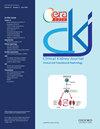Enhancing Vascular Access Planning in CKD: Validating the 40% KFRE Threshold for predicting ESKD in a French Retrospective Cohort Study
IF 3.9
2区 医学
Q1 UROLOGY & NEPHROLOGY
引用次数: 0
Abstract
Background Establishing the optimal timing for creating vascular access in patients with chronic kidney disease (CKD) is a critical and challenging aspect of patient management. The Kidney Disease: Improving Global Outcomes (KDIGO) guidelines propose using a 40% 2-year threshold based on the Kidney Failure Risk Equation (KFRE) for this purpose. However, the effectiveness of this threshold compared to traditional methods, such as estimated Glomerular Filtration Rate (eGFR), is not well-established. Methods In this monocentric retrospective cohort study, we analyzed data from patients referred for vascular mapping before arteriovenous fistula (AVF) creation between April 2013 and June 2023. The study aimed to compare the ≥ 40% 2-year KFRE threshold with a <15 mL/min/m²73 eGFR threshold for predicting End Stage Kidney Disease (ESKD). We assessed the probability of ESKD, considering death before AVF creation as a competing risk. Discrimination between KFRE and eGFR was evaluated using C-statistics. Results The study included 238 patients with a mean age of 65.2 years and a mean eGFR of 13.3 mL/min/m²73. Over a median follow-up of 10.7 months, 178 patients developed ESKD, and 21 died before ESKD. Probability of ESKD at 1 year was 77.6% (95% CI, 69.9-85.3%) using a ≥ 40% 4 variables KFRE threshold versus 65.8% (95% CI, 58.3-73.3%) using a <15 mL/min/m²73 eGFR threshold. The C-statistics indicated better predictive ability for the 8-variable KFRE at 6 months (0.82 (95% CI: 0.76-0.88)),while both 4 and 8-variable KFRE models were effective for 1-year predictions (0.835 (95% CI :0.78-0.89) and 0.82 (95% CI : 0.76-0.875) respectively). Sensitivity and specificity analyses favored the ≥ 40% KFRE threshold over the eGFR threshold. Conclusions This study suggests that using a ≥ 40% 2-year KFRE threshold for planning vascular access in CKD patients is promising and potentially superior to the traditional <15 mL/min/m²73 eGFR threshold. This approach may offer a balance between minimizing premature AVF creation and the risk of starting dialysis via a central venous catheter.加强慢性肾脏病患者的血管通路规划:在一项法国回顾性队列研究中验证用于预测 ESKD 的 40% KFRE 阈值
背景 为慢性肾脏病(CKD)患者建立血管通路确定最佳时机,是患者管理的一个关键和具有挑战性的方面。肾脏病:改善全球预后》(KDIGO)指南建议根据肾衰竭风险方程(KFRE)使用 40% 的 2 年阈值来达到这一目的。然而,与估算肾小球滤过率(eGFR)等传统方法相比,该阈值的有效性尚未得到充分证实。方法 在这项单中心回顾性队列研究中,我们分析了 2013 年 4 月至 2023 年 6 月间动静脉内瘘 (AVF) 创建前转诊进行血管测绘的患者数据。研究旨在比较≥40%的2年KFRE阈值和<15 mL/min/m²73 eGFR阈值,以预测终末期肾病(ESKD)。我们评估了 ESKD 的概率,并将建立 AVF 前的死亡作为竞争风险。使用 C 统计量评估了 KFRE 和 eGFR 之间的区别。结果 研究共纳入 238 名患者,平均年龄为 65.2 岁,平均 eGFR 为 13.3 mL/min/m²73。在中位 10.7 个月的随访期间,178 名患者出现了 ESKD,21 名患者在 ESKD 出现之前死亡。使用≥ 40% 4 变量 KFRE 阈值,1 年后出现 ESKD 的概率为 77.6%(95% CI,69.9-85.3%),而使用<15 mL/min/m²73 eGFR 阈值,出现 ESKD 的概率为 65.8%(95% CI,58.3-73.3%)。C统计表明,8变量KFRE在6个月时的预测能力更强(0.82(95% CI:0.76-0.88)),而4变量和8变量KFRE模型对1年的预测均有效(分别为0.835(95% CI:0.78-0.89)和0.82(95% CI:0.76-0.875))。敏感性和特异性分析显示,KFRE ≥ 40% 阈值优于 eGFR 阈值。结论 本研究表明,使用≥ 40% 的 2 年 KFRE 阈值来规划 CKD 患者的血管通路很有前景,可能优于传统的 <15 mL/min/m²73 eGFR 阈值。这种方法可以在最大限度地减少过早建立 AVF 和通过中心静脉导管开始透析的风险之间取得平衡。
本文章由计算机程序翻译,如有差异,请以英文原文为准。
求助全文
约1分钟内获得全文
求助全文
来源期刊

Clinical Kidney Journal
Medicine-Transplantation
CiteScore
6.70
自引率
10.90%
发文量
242
审稿时长
8 weeks
期刊介绍:
About the Journal
Clinical Kidney Journal: Clinical and Translational Nephrology (ckj), an official journal of the ERA-EDTA (European Renal Association-European Dialysis and Transplant Association), is a fully open access, online only journal publishing bimonthly. The journal is an essential educational and training resource integrating clinical, translational and educational research into clinical practice. ckj aims to contribute to a translational research culture among nephrologists and kidney pathologists that helps close the gap between basic researchers and practicing clinicians and promote sorely needed innovation in the Nephrology field. All research articles in this journal have undergone peer review.
 求助内容:
求助内容: 应助结果提醒方式:
应助结果提醒方式:


